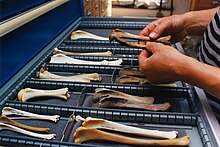Zooarchaeology: Difference between revisions
corrected (or '''archaeozoologist''') to (or '''archaeozoology''') |
Rescuing 2 sources and tagging 2 as dead. #IABot (v1.1) |
||
| Line 77: | Line 77: | ||
{{Commons category|Archaeozoology}} |
{{Commons category|Archaeozoology}} |
||
* [http://www.envarch.net/ Association of Environmental Archaeology] |
* [http://www.envarch.net/ Association of Environmental Archaeology] |
||
* [http://www.alexandriaarchive.org/icaz/icazForum/index.php?sid=a54aff158f650fc2b3eb43a998fed70d BoneCommons(ICAZ)] |
* [http://www.alexandriaarchive.org/icaz/icazForum/index.php?sid=a54aff158f650fc2b3eb43a998fed70d BoneCommons(ICAZ)]{{dead link|date=July 2016 |bot=InternetArchiveBot |fix-attempted=yes }} |
||
* [http://www.nmnh.si.edu/anthro/icaz International Council for Archaeozoology(ICAZ)] |
* [http://web.archive.org/web/20051214211402/http://www.nmnh.si.edu:80/anthro/icaz/ International Council for Archaeozoology(ICAZ)] |
||
* [http://www.archeozoo.org/en Archeozoo: collaborative website of archaeozoology] |
* [http://web.archive.org/web/20070303174017/http://www.archeozoo.org:80/en Archeozoo: collaborative website of archaeozoology] |
||
* [http://www.archeozoo.org/photos/index/categories?lang=en_UK ArchéoZooThèque : images bank in archaeozoology proposed by the website ArchéoZoo.org] |
* [http://www.archeozoo.org/photos/index/categories?lang=en_UK ArchéoZooThèque : images bank in archaeozoology proposed by the website ArchéoZoo.org]{{dead link|date=July 2016 |bot=InternetArchiveBot |fix-attempted=yes }} |
||
* [http://opencontext.org/sets/?cat=Animal+Bone OpenContext.org (Zooarchaeology data)] Multiple zooarchaeological datasets and media published in Open Context. |
* [http://opencontext.org/sets/?cat=Animal+Bone OpenContext.org (Zooarchaeology data)] Multiple zooarchaeological datasets and media published in Open Context. |
||
Revision as of 00:18, 21 July 2016

Zooarchaeology (or archaeozoology) is the study of faunal remains.[1] Faunal remains are the items left behind when an animal dies.[1] It includes: bones, shells, hair, chitin, scales, hides, proteins and DNA.[1] Of these items, bones and shells are the ones that occur most frequently at archaeological sites where faunal remains can be found.[1] Much of the time, most of the faunal remains do not survive.[1] They often decompose or break because of various circumstances.[1] This can cause difficulties in identifying the remains and interpreting their significance.[1]
Development
The development of zooarchaeology in Eastern North America can be broken up into three different periods.[2] The first being the Formative period starting around the 1860s, the second being the Systematization period beginning in the early 1950s, and the Integration period which began about 1969.[2] Full-time zooarchaeologists didn’t come about until the Systematization period.[2] Before that it was just a technique that was applied but not specifically studied.
Zooarchaeological specialists started to come about partly because of a new approach to archaeology known as “processual archaeology.”[3] This approach puts more emphasis on explaining why things happened, not just what happened.[3] Archaeologists began to specialize in zooarchaeology, and their numbers increased from there on.[3]
Uses

Zooarchaeology is primarily used to answer several questions.[3] These include:
- What was the diet like, and in what ways were the animals used for food?[3]
- Which were the animals that were eaten, in what amounts, and with what other foods?[3]
- Who were the ones to obtain the food, and did the availability of that food depend on age or gender?[3]
- How was culture, such as technologies and behavior, influenced by and associated with diet?[3]
- What purposes, other than food, were animals used for?[3]
Zooarchaeology can also tell us what the environment might have been like in order for the different animals to have survived.[3]
In addition to helping us understand the past, zooarchaeology can also help us to improve the present and the future.[4] Studying how people dealt with animals, and its effects can help us avoid many potential ecological problems.[4] This specifically includes problems involving wildlife management.[4] For example, one of the questions that wildlife preservationists ask is whether they should keep animals facing extinction in several smaller areas, or in one larger area.[4] Based on zooarchaeological evidence, they found that animals that are split up into several smaller areas are more likely to go extinct.[4]
Techniques
One of the techniques that zooarchaeologists use is close attention to taphonomy.[2] This includes studying how items are buried and deposited at the site in question, what the conditions are that aid in the preservation of these items, and how these items get destroyed.[2] Then they interpret that information.[2]
Another technique that zooarchaeologists use is lab analysis.[2] This analysis can include comparing the skeletons found on site with already identified animal skeletons.[2] This not only helps to identify what the animal is, but also whether the animal was domesticated or not.[2]
Yet another technique that zooarchaeologists use is quantification.[2] They make interpretations based on the number and size of the bones.[2] These interpretations include how important different animals might have been to the diet.[2]
Zooarchaeology and related fields
As can be seen from the discussion about the name that should be given to this discipline, zooarchaeology overlaps significantly with other areas of study. These include:
- Anthropology
- Anthrozoology
- Archaeology
- Biology
- Ecology
- Ethnography
- Paleopathology
- Palaeontology
- Paleozoology
- Zoology
Wider areas of study
Such analyses provide the basis by which further interpretations can be made. Topics that have been addressed by zooarchaeologists include:
|
|
References
- ^ a b c d e f g Yohe II, Robert M. (2006). Archaeology: The Science of the Human Past. Pearson. pp. 248–264.
- ^ a b c d e f g h i j k l Landon, David B. (2005). "Zooarchaeology and Historical Archaeology: Progress and Prospects". Journal of Archaeological Method and. 12 (1).
- ^ a b c d e f g h i j Thomas, Kenneth D. (1996). "Zooarchaeology: Past, Present and Future". World Archaeology. 28 (1): 1–4. doi:10.1080/00438243.1996.9980327. PMID 16475284.
- ^ a b c d e Lyman, R. L. (1996). "Applied Zooarchaeology: The Relevance of Faunal Analysis to Wildlife Management". World Archaeology. 28: 110–125. doi:10.1080/00438243.1996.9980334.
Sources
- Orton, David C. "Anthropological Approaches to Zooarchaeology: Colonialism, Complexity and Animal Transformations." Cambridge Archaeological Journal 21.2 (2011): 323-24. Print.
External links
- Association of Environmental Archaeology
- BoneCommons(ICAZ)[permanent dead link]
- International Council for Archaeozoology(ICAZ)
- Archeozoo: collaborative website of archaeozoology
- ArchéoZooThèque : images bank in archaeozoology proposed by the website ArchéoZoo.org[permanent dead link]
- OpenContext.org (Zooarchaeology data) Multiple zooarchaeological datasets and media published in Open Context.
